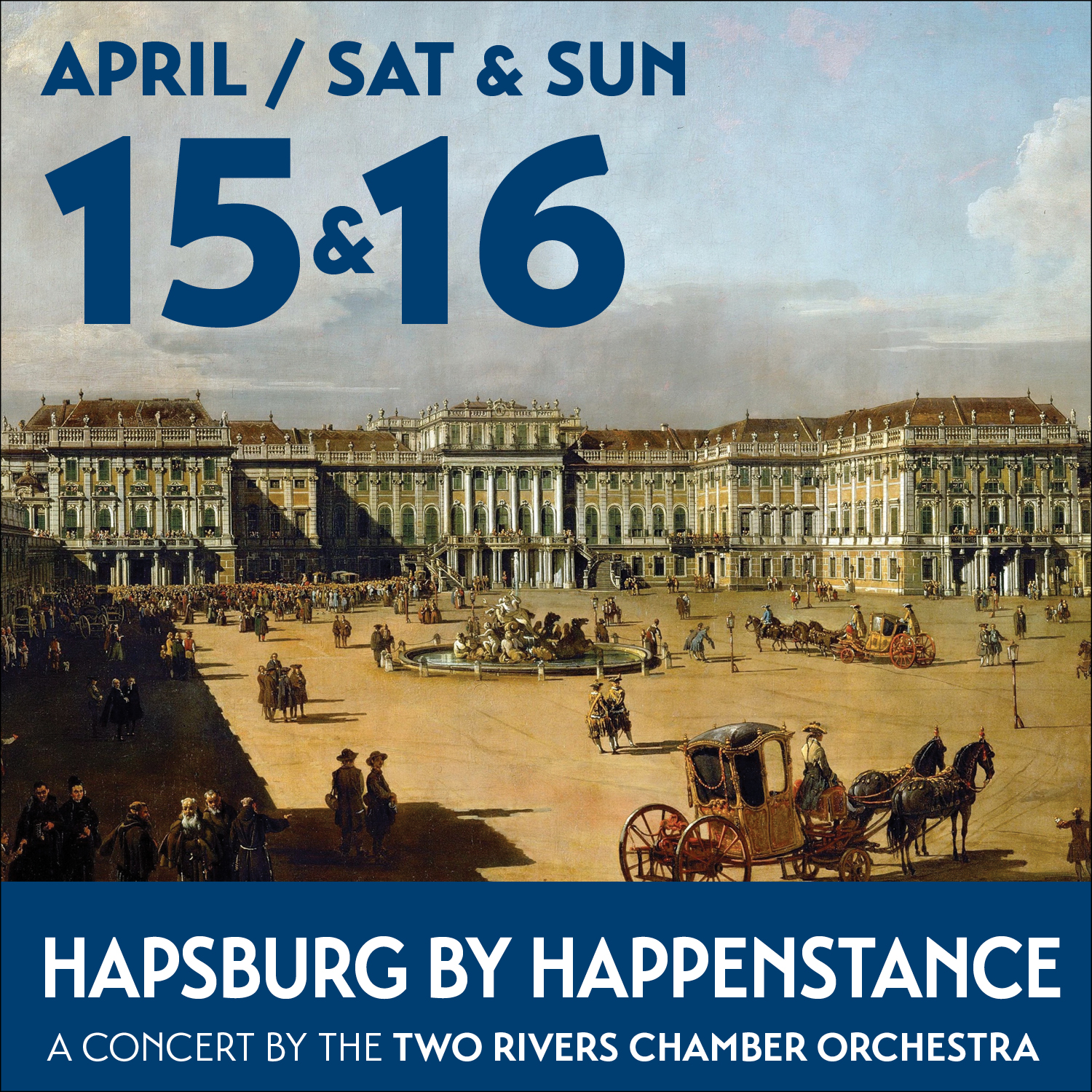Hapsburg by Happenstance – April 15 & 16, 2023
 PROGRAM NOTES
PROGRAM NOTES
Wolfgang Amadeus Mozart
(Born in Salzburg, Austria in 1756; died in Vienna in 1791)
Piano Concerto No. 12 in A major, K. 414
- Allegro in A major
- Andante in D major
- Allegretto in A major
The fact that Mozart needed to convince the city of Vienna that he should be better regarded as both a virtuoso pianist and a composer tells us something about the world of music in that city in 1782. Vienna had an insatiable appetite for music, yet it was not easily impressed nor—ironically—especially sophisticated. That combination would set Mozart’s teeth on edge throughout his career, especially with regard to his piano concertos. But in 1782, not long after he had moved from Salzburg to settle permanently in Vienna and had married, Mozart was determined to win over the fickle Viennese with three extremely charming piano concertos: his 11th, 12th and 13th. Indeed, in a letter to his father, Mozart described these concertos as:
… a happy medium between what is too easy and too difficult; they are very brilliant, pleasing to the ear, and natural without being vapid. There are passages here and there from which the … connoisseurs alone can derive satisfaction; but these passages are written in such a way that the less learned cannot fail to be pleased, though without knowing why.
Mozart’s Piano Concerto No. 12 is certainly pleasing to the ear and anything but vapid. Charming and perfectly urbane, the first movement begins with a delightfully spirited theme that is then taken up by the piano soloist. The movement is full of light and gentle wit, perfect not only for the Viennese in the late 18th century but for any concertgoer anywhere anytime. Listen here for a characteristic of Mozart’s early concertos: The piano is typically set apart from the orchestra, often playing extended solo passages or with only the lightest accompaniment. The effect is articulate and enchanting.
For the “connoisseurs,” the second movement begins with a nearly direct quote of part of a theme written by Johann Christian Bach (1735–1782, son of Johann Sebastian) in the overture to his 1763 opera La calamita de’ cuori. While on extended tour as a young piano prodigy, the eight-year-old Mozart had met Johann Christian in London and become quite fond of him and his music. When Mozart wrote his Piano Concerto No. 12, the “London Bach” had just died earlier the same year, and the beginning of the second movement pays homage to him. Regardless of this movement’s origins, however, every listener can simply luxuriate in its gorgeousness. In its beautiful Andante, sophistication is created out of simplicity and poignancy––a hallmark of Mozart’s genius.
The Allegretto completes this concerto with a wonderful rondo (a cyclical form within which sections return) which allows the orchestra and piano to trade and play with several themes, all accomplished cleverly and stylishly. Including some charming little piano cadenzas, the movement is immensely refreshing, and brings this delightful concerto to a refined yet energetic close.
A performance note: Mozart was not only the piano soloist at the premiere of his Concerto No. 12 but also the conductor. This practice of conducting from the keyboard has a long history that predates Mozart. Well before conductors came into their modern existence, players of keyboard instruments often led/conducted their ensembles; in fact, one of the Bach sons found this to be the most superlative way of keeping an orchestra together. Nonetheless, Mozart’s dual performance roles became legendary in his own day, and thus, Maestro Jed Gaylin continues a great tradition that Mozart himself made famous in Vienna.
Anton Webern
(Born in Vienna, Austria in 1883; died in Mittersill, Austria in 1945)
Langsamer Satz (“Slow Movement”)
This exquisite work was composed in 1905, early in Anton Webern’s career, when his compositions were tonal, highly chromatic, and steeped in the ethos of the Romantic era. Its title, Langsamer Satz (literally, “Slow Movement”), suggests that Webern may have intended it to be part of a full-fledged string quartet. Yet he never wrote any more movements. The short work remained unpublished and seems to have been shelved and nearly forgotten until nearly 20 years after his death, when it finally received its premiere at a concert in Seattle, Washington, in 1962. Three decades later, in 1992, the Seattle Symphony conductor Gerard Schwartz arranged the piece for string orchestra. Since its reemergence, musicians and audiences have found this brief, orphaned work, with its tenderness and rapturous beauty, to speak completely for itself—its possible place in a never-completed string quartet unnoticed.
At the time of the work’s writing, 1905, Webern had just begun studying composition with Arnold Schoenberg in Vienna. Around 1919, Schoenberg, Webern, and his fellow pupil Alban Berg would later usher in an entirely new method of composing now known as “serial,” or 12-tone, music. Webern’s serial approach was unique, however: His works were concise, given to utter clarity almost above all else, and infused with an uncanny lyricism. Because of these guiding principles, Webern’s short list of his 12-tone works are often celebrated as rarefied musical gems. And though Langsamer Satz was created long before his serial works, Webern’s guiding principles of clarity, concision and lyricism infuse this work and all his early Romantic works just as significantly.
Langsamer‘s beguilement, too, is certainly owed in part to its inspiration from a particularly wondrous time in Webern’s life. Indeed, just before this work’s creation, Webern had just taken a holiday in the Alps with his cousin, Wilhelmine Mörtl, and he was head-over-heels in love with this young woman who would later become his wife. As Webern wrote in his diary in 1905:
To walk forever like this among flowers, with my dearest one beside me, to feel oneself so entirely at one with the universe, without care, free as the lark in the sky above—O what splendor! …. When night fell (after the rain) the sky shed bitter tears, but I wandered with her along a road …. A coat protected the two of us. Our love rose to infinite heights and filled the Universe. Two souls were enraptured.
In the mere 10 or so minutes of this piece, Webern seems to capture those ecstatic, joyful, contented emotions. The piece is cast in three sections, beginning with a main theme that is full-blown ecstasy. Here, the violins set out with an achingly beautiful and lyrical song that will soar into the infinite blue sky. A delightful passage that contrasts with this theme soon appears, featuring the lower strings accompanying in pizzicato (plucked strings). The music in this section is filled with sweet energy as well as vulnerability, as if Webern is evoking his fluttering heart. In the work’s short central section, a second theme is introduced, joyful and poetic, with violins and cello trading bits of this new theme back and forth, like sweethearts. These two themes come together to fill out the last section, flowing but intense and luxuriating in their harmonies. The plucked strings reappear, this time with a heart-catching tenderness, and this may be one of the loveliest moments in all of Webern’s music. After another, gentler climax, the concluding section quietly fades into a contented lovers’ twilight, which Webern has repeatedly marked zögernd—a musical direction meaning “lingeringly.”
Franz Josef Haydn
(Born in Rohrau, Austria in 1732; died in Vienna in 1809)
Symphony No. 44 in E minor (Trauersymphonie), H. I/44
- Allegro con brio
- Menuetto e Trio; Allegretto
- Adagio
- Presto
Haydn created his beloved Symphony No. 44 (nicknamed the Trauersymphonie—trauer meaning “mourning”) in 1772. At that time, he was about halfway through his long journey of writing his 104 symphonies, and in true Haydn form, he was continuing to experiment with the genre. During the same period, German artists in both literary and musical circles were using the sturm und drang (“storm and stress”) technique, a proto-Romantic aesthetic. In music, the idea was to turn away from rationalism and classicism and to give more freedom to experimentation, the emotions, and disquiet. Since Haydn was “cut off from the word,” (as he humorously described it) by his role as Kapellmeister (director of music) for the Austrian Esterhazy Estate, he was able to experiment without censure. Indeed, his 104 symphonies run a most wonderful gamut of experimentation in form, humor, and emotionalism, as well as early forays into chromaticism. We see this in his Symphony No. 44, which specifically stands out for its unrelenting energy and its unique exploration of pathos.
Symphony No. 44 is one of only a few of Haydn’s symphonies written in a minor key, which in the 1770s would have been perceived as a uniquely serious tonal world. The very opening of the first movement bears this out: It is strident and edgy, as though something gravely important, even sinister, is afoot. Notice, too, how the dynamics begin loud (forte) and then immediately drop to soft (piano)—a technique used here for emotional affect, to keep listeners at the edge of their seats. These abrupt dynamic changes occur throughout the symphony, but they are especially prevalent in this first movement. With its thematic emotional gravitas and its dynamic jangling, together with a pulsing motive that permeates the entire movement, Haydn’s techniques are delightfully tense and thrilling.
The second movement is a menuetto (a stately dance) which by the late 18th Century was typically placed as the third movement in symphonies. But Haydn here is experimenting with pacing and balance: After the intense first movement, a light dance stabilizes the symphony’s weight. Nevertheless, the themes in this Menuetto’s first section also flirt with dark emotions, despite their parlor-waltz characteristics. Haydn also marks the score as canone in diapason, meaning “canon in the octave [apart].” A canon is a musical form that repeats its melody in a delayed manner, so that the two (or more) iterations soon play in harmony with each other. You can hear this canon technique immediately in this Menuetto’s very first bars, as well as throughout the movement. But where ordinarily these themes tumbling about themselves might seem jolly, in this case Haydn has created a mesmerizing feeling of the singing of repetitive sorrows. Only in this movement’s middle section, the trio, do we hear a bit of major-key sunshine, which feels all the brighter in contrast to what has come before. The beginning theme returns to close the movement somberly.
The slow third movement, “Adagio”. is one of Haydn’s loveliest creations. Musical lore tells that Haydn asked for this movement to be played at his funeral. That may be apocryphal, but we do know for certain that this adagio was played at a commemorative concert in Berlin in 1809 after Haydn died. Hence, the reference to mourning in the symphony’s nickname. In tone, this movement pulls away from the symphony’s turbulence and darkness and instead explores serenity, moving with simplicity and with few frills. The melody is gently active, its accompaniment unrushed, and its feel is calming and content. A particularly beautiful section occurs when the upper strings sing above a quietly undulating triplet figure in the lower strings.
The frenetic finale, however, leaves no prisoners. The pace is breakneck—a cyclone of driving energy. The beginning, and main, theme is played in unison in the strings, evoking a feeling of an urgent statement. From there, Haydn creates a race to the last bars with an almost inexorable relentlessness. Extraordinary, too, is how much energy comes surging out of the few instruments that Haydn scored for: only two oboes (often bassoons), two horns, and the typical strings. Listen also for the abrupt dynamic changes in this movement and more canonic writing, all of which serve to create one of the most breathlessly exciting finales in any of Haydn’s symphonies.
© Max Derrickson



